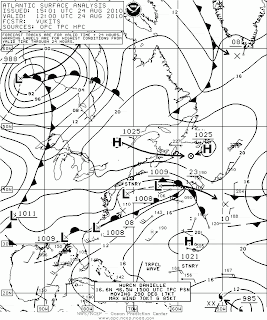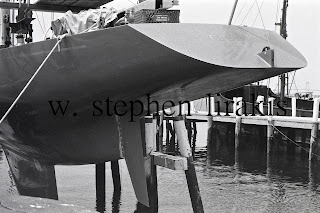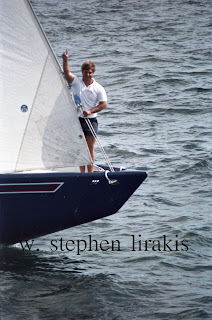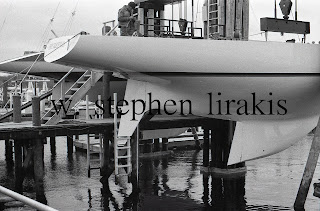This is thanks to Sailing Anarchy.
Month: August 2010
1983 America’s Cup, when the right thing happened
 |
| going to the finish |
 |
| rounding the first leeward mark |
 |
| liberty |
 |
| australia II |
 |
| before the start |
 |
| the morning after |
 |
| Marble House |
 |
| the CUP in 1983 |
1983, a date in America’s Cup history that will forever be remembered. The unthinkable happened. the New York Yacht Club and the United States lost a cup that they had held since 1851 (having won it as an upstart nation)
For me, the right thing happened for all the wrong reasons. As hard as it was to see then, the America’s Cup had outgrown the New York Yacht Club. This forced change breathed new life into the competition. People can think that it was the cause of the problems we have seen since, I do not believe this to be true. It would have happened anyway. It is the world we live in. Change always comes difficultly.
Newport, oddly was routing for the underdog, Australia,. This was spiting your face by cutting off your nose. Tourism in Newport was closely tied to the America’s Cup.
Another thought, “Liberty” led the seventh and final race for five of the six legs. sailing brilliantly against a clearly strong rival. “Liberty” was not a slow boat, just not a faster boat. The Australian boat was using Ian Howlett’s bendy mast, giving them “free” sail area. The wing keel was probably more a psychological weapon than an effective design improvement. It was long from being understood. It did make a stiffer boat allowing a lower lead package.
Curiously, the C-class may be facing the same sort of challenge to change, For so long being the step-sister, they may now find themselves in the center of significant changes, namely the America’s Cup in multihulls.
1983 America’s Cup, when the right thing happened
 |
| going to the finish |
 |
| rounding the first leeward mark |
 |
| liberty |
 |
| australia II |
 |
| before the start |
 |
| the morning after |
 |
| Marble House |
 |
| the CUP in 1983 |
1983, a date in America’s Cup history that will forever be remembered. The unthinkable happened. the New York Yacht Club and the United States lost a cup that they had held since 1851 (having won it as an upstart nation)
For me, the right thing happened for all the wrong reasons. As hard as it was to see then, the America’s Cup had outgrown the New York Yacht Club. This forced change breathed new life into the competition. People can think that it was the cause of the problems we have seen since, I do not believe this to be true. It would have happened anyway. It is the world we live in. Change always comes difficultly.
Newport, oddly was routing for the underdog, Australia,. This was spiting your face by cutting off your nose. Tourism in Newport was closely tied to the America’s Cup.
Another thought, “Liberty” led the seventh and final race for five of the six legs. sailing brilliantly against a clearly strong rival. “Liberty” was not a slow boat, just not a faster boat. The Australian boat was using Ian Howlett’s bendy mast, giving them “free” sail area. The wing keel was probably more a psychological weapon than an effective design improvement. It was long from being understood. It did make a stiffer boat allowing a lower lead package.
Curiously, the C-class may be facing the same sort of challenge to change, For so long being the step-sister, they may now find themselves in the center of significant changes, namely the America’s Cup in multihulls.
C-class August 27 2010
 |
| harbour court 8 27 10 |
 |
| “Invictus” airbus team |
 |
| match race, “canaan” “orion” |
 |
| tug of war |
A morning northerly and sunshine greeted everyone. It seemed to reflect the spirits ashore. The top two boats were paired in match racing, “Canaan” is so fast, even if Glen Ashby and James Spithill won the start they were hard pressed to keep control.
A little to windward of the start two tugs gave meaning to the words “tug of war” as they pulled against one another with force; to what end was unclear.
 |
| guy gurney, bob fisher, dan nerney, b. hovey |
It seems more and more likely that the next America’s Cup will be sailed in 72 foot catamarans, in Valencia, Spain.
What a difference a day makes/ C-class sunshine
 |
| harbour court august 26 2010 |
 |
| cogito rig in ruins |
 |
| the french-patient lady iv |
 |
| the start |
 |
| canaan (fred eaton/magnus clarke) |
 |
| alpha (glenn ashby/james spithill) |
Yesterday saw the destruction of “Cogito’s” rig. The French capsized on the way out to the start today and towed back to the dock missing all the races today. “Canaan” won the three races, followed by “Alpha”
This regatta has attracted a lot of attention. Most of the designers and project managers for the potential America’s Cup syndicates have come to look. In 2004 the last time this event was on Narragansett Bay it was a lonely site.
Steve Killing who designed three of the boats here(Canaan,Alpha,Orion) should feel proud; his boats are showing great form.
This is truly a developmental platform that is exciting; the possibilities for exploring speed are almost limitless.
C-class Catamarans blown out for a second day
 |
| Harbour court today |
 |
| wings under the tent |
 |
| Dave Hubbard and Duncan Maclean |
 |
| “Cogito” at speed |
 |
| Duncan and Steve Clark |
The big low that has been almost stationary over our area, brought an abrupt end to the heat of summer. It also brought plenty of wind and rain. The “C” class competitors who have travelled far to race against one another have been grounded for the last two days. Tomorrow should bring lower winds followed by sun.
These boats have long been at the fringe of the yachting world. It is the recent America’s Cup and the use of a wing mast by Oracle that has brought them out of the shadows.
C-class Catamarans are in Newport
 |
| wings in the mule barn |
 |
| duncan measuring |
It is raining, the rigs are in the mule barn at Ft. Adams being measured by none other than Duncan MacLean.
Racing starts tomorrow, weather permitting. Unfortunately the forecast may not be what anyone hoped for; that’s sailboat racing. It does not diminish the excitement of having these boats assembled in one place.
Paul Larsen and Helena Darvilia are here with “Invictus” the Airbus entry. Steve Clark with his new boat and old rig having had teething problems with the new one. Steve Killing’s design, the defender, is here. The French have chartered “Patient Lady IV”.
America’s Cup 1980
1980 brings ever increasing interest in the America’s Cup. Ian Howlett, who has had an abiding interest in the meter rule since he was young, designs “Lionheart”; named after a contest in England. He had explored the rule extensively and came up with the bendy mast. This added unrated sail area.
“France III” has her best showing ever, making to the Defender finals, losing to” Australia.”
“Clipper” designed by David Pedrick for Russell Long, probably needed more time to get the boat going fast. “Freedom” the last Successful Sparkman&Stephens 12 meter, again with small incremental changes, sailed by Dennis Connor. Dennis, with this challenge brought the America’s Cup to a new level. He logged more hours of sailing in more conditions than anyone had previously done, leaving no part of the 12 meter rule unexplored. Truly a well prepared defense. “Freedom” almost unbeatable in the trials; becoming the defender against “Australia” designed by Ben Lexan and Johan Valentijn winning 4 to 1 in the races themselves.
A new benchmark was set, and the course to where the America’s Cup is today was launched.
My involvement in the America’s Cup finished in 1979 after Gerry Driscoll could not raise money to bring “Intrepid” back again. I was fully involved in Lirakis Safety Harness, and in fact stopped sailing altogether in 1980 until 2001, for the America’s Cup Jubilee.
AMERICA’S CUP 1978-1979
The 1977 America’s Cup was done and dusted. Already plans for the 1980 cup were underway. Baron Bic built “France III”, designed by Johan Valentin. (who would co-design “Australia” with Ben Lexan for 1980)
Bic also owned “Intrepid”, which was being used as a trial horse against “France III.” In the summer of 1978 “Intrepid” had a host of skippers: Bill Ficker, Lowell North, Gerry Driscoll. “France III”also had a series of tryouts for skipper, including Bruno Trouble.
Gerry Driscoll arrived at an agreement with Baron Bic, who agreed to lease “Intrepid” to Gerry for the 1980 America’s Cup if he could find financing for the program.
1979, I was crew boss, downwind helmsman, and tactician. I was also responsible for maintenance of the boat; the actual work being carried out by the French shore crew.
In over 100 starts, we lost one. Gerry owned the starting line, and was the most consistent helmsman I ever sailed with, every tack was the same, which meant the crew could always have the same timing.
Many good stories came from this season, but no money was found for Intrepid’s comeback.
12 meter racing before 1958
http://www.britishpathe.com/record.php?id=1079
Leading up to the 12 meter era reunion, this should amuse those who sailed competitively on 12 meters














